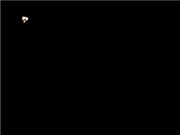
Purpose:
Observe and photograph International Space Station (ISS). Continue to track
asteroid 4 Vesta.
Location:
Chula Vista Gliderport. Conditions: clear, calm winds.
Time:
Begin 20:00 PDT 20 MAY 2003, end 23:00 20 MAY 2003.
Summary:
The ISS was scheduled to make an overhead pass over San Diego on 20 MAY 2003.
The near six-minute pass would begin about 21:20 and end about 21:26.
To record a detailed image of it under magnification required manual tracking and some luck. The methodology included recording a long strip of video using the modified Toucam Pro mounted on an Orion 8" Skyview Pro, and adjusting the settings as it went.
Exposure would be tricky. The initial exposure was set to the same as what worked for Jupiter. In this case, it was 1/100 to 1/500 sec, with gain set low (about 20%).
The resulting clip was about two minutes in length and measured nearly 2GB. It was processed in K3CCD Tools. From 2,183 still frames, 35 contained images of the ISS. Four were congruous, and the rest discounted due to distortion as a result of slew motion or atmospheric turbulence.
Best results:
Frame 394, at about 3:26 into the overhead passage.
Frame 412, at about 3:27 into the overhead passage.
Crop of frame 412, at about 3:27 into the overhead passage.
Frame 418, at about 3:27 into the overhead passage, shows distortion.
Frame 419, at about 3:27 into the overhead passage.
Other observations:
Asteroid 4 Vesta, has made the turn around 12 Virginis and is picking up apparent speed.
A departing aircraft goes through the Vesta field for an interesting effect.
Jupiter as imaged through a videocam and the 8" Orion.
Conclusion.
The best images of ISS were obtained with the station nearly overhead. Therefore, the imaging effort should be concentrated during the central two minutes of the passage, even though that is the period in which the station will have the highest apparent motion.
Images are copyright ©2002 Paul C. Martinez & Philip Brents. They may be used for any educational or scientific use - however, please reference or link to this page if you do so.